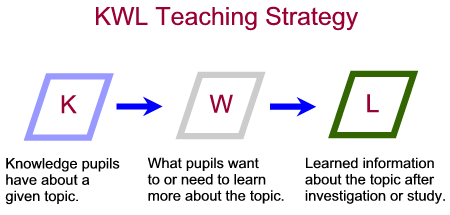
What is K-W-L Learning? (Ogle, 1986)

KWL Learning Visual Concept Diagram
Description
KWL is a teaching strategy that helps pupils develop tactical ways to learn new material with the use of questioning and accessing information from reliable sources. This strategy can be effective in promoting independence in learning. The ages and stages of development will determine the role the teacher plays in guiding pupils through the KWL process. However, if the model is used for the first time, it is highly recommended that the teacher directs the process and models the steps.
Principles Components
KWL represents three principle components:
- K = what is "known" [K] according to prior knowledge
- W = determining what pupils "want" [W] to learn
- L = identifying what pupils "learn" [L] after instructional events
Procedures
- Use a KWL worksheet with your pupils and begin with asking them what they know about a given topic. Generate as many ideas on the topic as possible relying on pupils' prior knowledge. Record the ideas in the first column. This completes the "K" component of the strategy (what is known.)
- Once the "K" column is complete with all possible ideas, begin to categorize the information. This step helps pupils to organize information that is then used to structure the content for the next step: formulating questions to be investigated that bring more meaning and clarity to the topic.
- Based on step 2, pupils are ready to generate questions that are the basis for the second component: the "W" of the strategy (what pupils want to learn). Once the questions are formulated and agreed upon, record the list in the second column.
- This step depends on the developmental stages and needs of pupils. In any case, this step includes accessing, reading, researching or collecting information from sources provided by the teacher or from sources pupils independently use to respond to the questions formulated. In this step, pupils may generate more questions as they find information to support their topic (that can be added to the list in the column representing the "W" of the strategy).
- Simultaneously, as they complete step 4, new information can be recorded in the "L" column (what pupils learn).
- Once the "L" column is complete and pupils determine that they have enough information on the topic they have been investigating, categorize the information and create statements about the topic (new knowledge).
This last step can be implemented in a variety of ways. The information on any given topic can be represented in a summary or outline (writing exercise), or in a graphic organizer (mapping, charts, etc.).
We offer a wide range of KWL Worksheets to assist you with the KWL Learning Strategy.